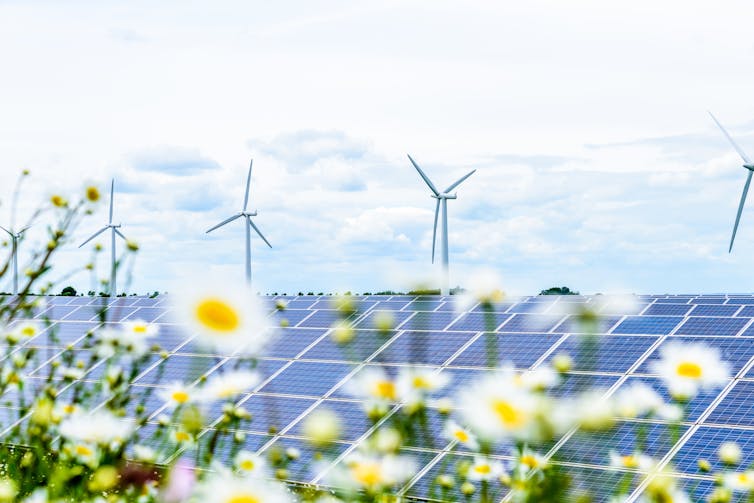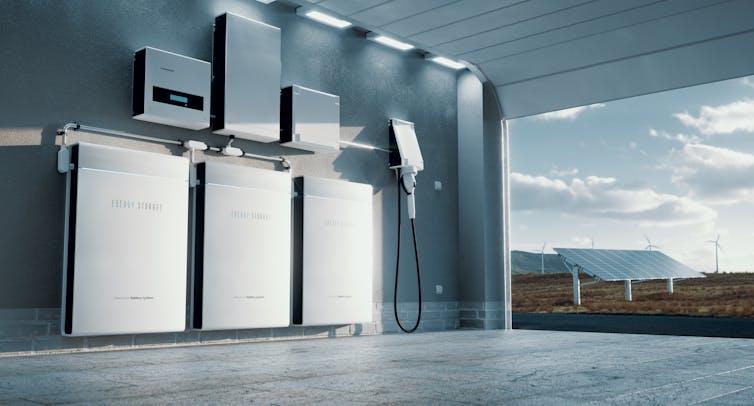Jonathan Radcliffe, University of Birmingham
Thanks in part to the pandemic-induced economic slowdown and the collapse of coal and triumph of wind power over the last decade, a new analysis suggests the UK is halfway to meeting its net zero greenhouse gas emissions target. The ultimate goal of a fully renewable grid will depend on technology that can store clean electricity from wind farms for hours and days.
Since I began writing about energy storage in 2013, falling costs have prompted a surge in batteries being installed around the world. Just as silos store excess grain on farms for when it’s needed during lean periods, grid batteries store additional energy so that it can be used to keep the lights on when supply fails to match demand.
Historically, fossil fuels have provided that buffer in the energy system. Coal, oil and gas can be burned whenever needed to keep people driving, heating homes and turning on appliances. But tackling climate change will mean shifting to renewable energy generation – which can be patchy when the sun isn’t shining and the wind isn’t blowing – and swapping gas boilers and combustion engines for alternatives powered by clean electricity.

By 2030 there could be more than ten million electric vehicles on UK roads, and more than a million homes a year having electric heat pumps installed. The UK’s capacity for electrical energy storage is projected to increase up to three times by 2030, and ten times by 2050. That would mean 12 and 40 gigawatts respectively. Meanwhile, peak energy demand could grow to 60 and 80 gigawatts over the same period.
Without adequate preparation, the rapid expansion of storage technologies could actually disrupt the functioning of the energy system and obstruct progress to a net-zero society.
Missed opportunities
The UK government recently announced plans to fund companies that come forward with new technologies for large-scale energy storage. But their incentives to build grid storage technology at the appropriate scale are falling short.
By the end of 2020, only about 600 megawatts of battery storage was running on the UK’s grid. As renewables like wind and solar increase to two or three times their current levels by 2030, energy surpluses and deficits will become more extreme. Large-scale storage could help balance the peaks and troughs, but companies aren’t being paid enough to justify the cost of building new storage in the first place.
As a result, the UK is missing an opportunity. New energy storage technologies that can capture large amounts of electricity generated by wind or solar power when there’s too much of it and feed it back into the grid when it’s needed save money by reducing waste. A smart grid with such storage could reduce costs in the energy system by up to £40 billion (US$56 billion) by 2050.
Public subsidies could encourage companies to build and operate sufficient energy storage as more wind and solar is deployed, and the initial costs to the consumer would be returned through lower bills over time as energy system costs fall. Early support for new storage technologies will probably slash their cost too. This is what happened with renewables like wind and solar power, which are now cheaper than fossil fuel generation. And by attracting companies developing energy storage to the UK, a national industry will bloom. At the moment, the market for energy storage is largest in the US and that’s where industry investment is heading.
Preparing for the transition
Several companies are offering to pay owners of energy storage devices (like home batteries) a fee to manage their devices over the internet – instructing the device to charge or discharge to the National Grid when necessary. Consumers can charge home batteries with electricity from the grid when it’s cheap (normally at night), and use this stored energy instead of buying more expensive electricity from the grid during the day. Millions of home storage devices could eventually charge and discharge according to algorithms in order to minimise costs to the consumer. But without strategies and tools to handle the effects of storage distributed across millions of buildings and electric vehicles, costs could mount on the companies managing the electricity infrastructure and grid operators.

Energy storage will also need to integrate heat, power and mobility. Hot water tanks will be connected to electric heat pumps in buildings and electric vehicles will become mobile storage devices, potentially capable of selling electricity back to the grid. Storage will be the piece of the jigsaw that all the other pieces fit around.
These changes will alter the way people pay for their energy supply, as more of it goes towards electricity that warms homes, fuels vehicles and powers appliances. New supplier models are being tested where consumers pay for levels of warmth at home, or unlimited electricity deals similar to mobile phone plans. But how will the government protect consumers while still expecting them to pay for the costs of investment?
If the government fails to build enough storage to keep up with renewable generation, the grid will need fossil fuels to balance supply and demand. The uncoordinated charging and discharging of private batteries by consumers will make maintaining a stable grid costly, too. And as our energy use becomes more integrated across heat, power and transport, how the low-carbon transition will affect consumers is uncertain. Energy storage can help transform energy systems on the path to net zero emissions, but only if these challenges aren’t ignored.
Jonathan Radcliffe, Senior Research Fellow, Energy Storage, University of Birmingham
This article is republished from The Conversation under a Creative Commons license. Read the original article.
